This past July, I had the honor of being selected as one of 79 “38th Voyagers” to sail on the restored whaling ship Charles W. Morgan, as she made her way along the New England coast. The program, through Mystic Seaport in Connecticut, and partly funded by a grant from the National Endowment for the Humanities, sought to bring artists, scientists, writers, and other academics on board, to see what their experiences would create.
I was placed in the Provincetown to Boston leg, and what follows is my own experience on the ship:
Part One
“I know not all that may be coming, but be it what it will, I’ll go to it laughing.” – Herman Melville, Moby Dick
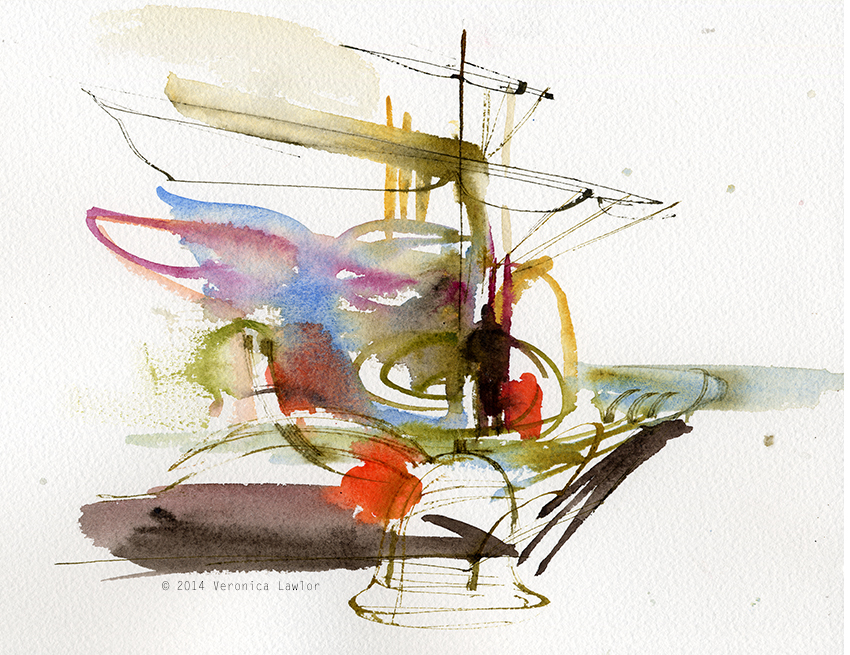
Sailing on a 19th Century whaling ship is not something I ever expected to do in my life. The whaling industry is not a particularly appealing part of American history: the hunt seems so harsh to 21st Century eyes. And yet, in doing research and reportage of the restoration of the Charles W. Morgan at Mystic Seaport, I came to respect the ship and the hard work of her sailors, and to understand the importance of the whaling industry to the growth of our country. We can’t ignore our whaling past, or judge it through the eyes of today, but rather we can shift our rudder with the knowledge we have now, to a new relationship with the whales and our environment. That is the message of the Morgan’s sail, and a timely one too. So it was with great enthusiasm that I got myself ready for to be a part of this very symbolic voyage.
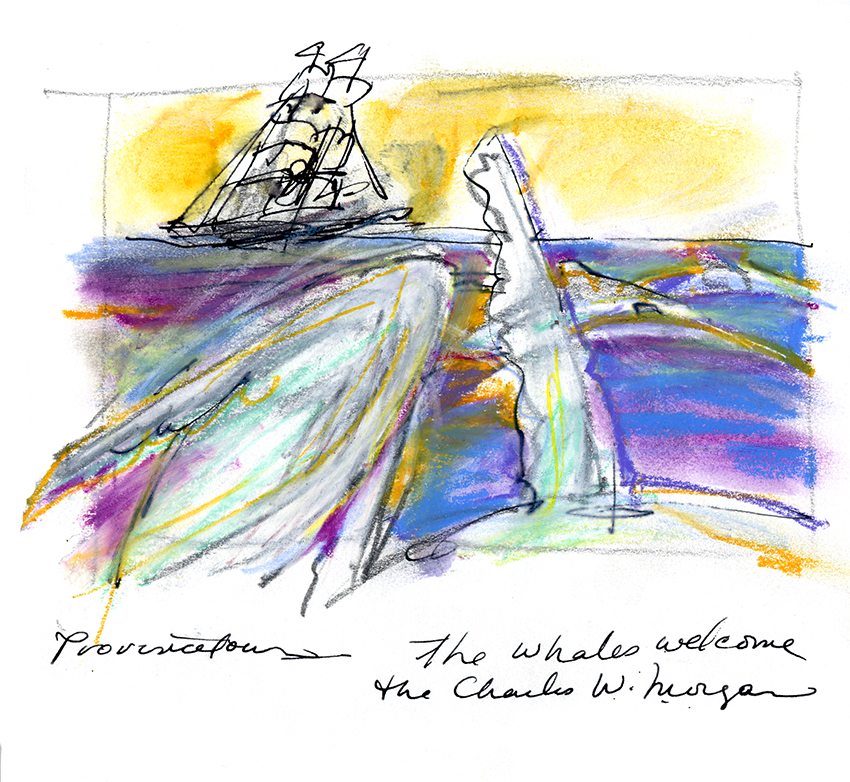 The weekend before our sail, the Morgan had made a few day trips out to the Stellwagen Bank Marine Sanctuary, off the coast of Provincetown. There she made contact with humpback whales, closing the gap between the past and the present in one glistening whale spout. “Thar she blows!” elicited cries of joy and clicks of cameras instead of thrusts of harpoons. The whales, to my mind, were quite forgiving, and swam up to the ship and little whale boats without trepidation. It was a beautiful few days, the sun was shining, and the Morgan was in full sail. I looked forward to more of the same. On a whale watch before my departure date, my husband and I saw many whales – spy hopping, fluking, breaching. On the horizon, a huge humpback rose to breach and fell, hitting the ocean like a small building. It seemed to my active imagination that the whales were celebrating the new spirit of co-operation between us and them that existed after the encounters of the weekend.
The weekend before our sail, the Morgan had made a few day trips out to the Stellwagen Bank Marine Sanctuary, off the coast of Provincetown. There she made contact with humpback whales, closing the gap between the past and the present in one glistening whale spout. “Thar she blows!” elicited cries of joy and clicks of cameras instead of thrusts of harpoons. The whales, to my mind, were quite forgiving, and swam up to the ship and little whale boats without trepidation. It was a beautiful few days, the sun was shining, and the Morgan was in full sail. I looked forward to more of the same. On a whale watch before my departure date, my husband and I saw many whales – spy hopping, fluking, breaching. On the horizon, a huge humpback rose to breach and fell, hitting the ocean like a small building. It seemed to my active imagination that the whales were celebrating the new spirit of co-operation between us and them that existed after the encounters of the weekend.
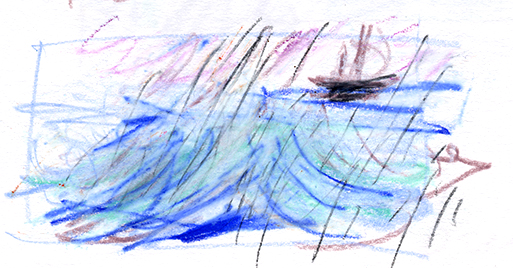 On Sunday evening before our scheduled Tuesday trip, we received a text message – be prepared to wait. The skies were turning ominous, and the forecast for Tuesday was severe thunderstorms. I wanted to experience a bit of the life of a sailor, but I wasn’t sure how far that desire went. Monday morning at 6 am, the decision was made and another text sent out. We would sail on Tuesday, if only to beat the storm that was quickly heading toward Boston. Be prepared for rough seas and rain, it said. OK, I thought, I can do this. I packed my gear, a little dramamine, and looked forward to the adventure to come.
On Sunday evening before our scheduled Tuesday trip, we received a text message – be prepared to wait. The skies were turning ominous, and the forecast for Tuesday was severe thunderstorms. I wanted to experience a bit of the life of a sailor, but I wasn’t sure how far that desire went. Monday morning at 6 am, the decision was made and another text sent out. We would sail on Tuesday, if only to beat the storm that was quickly heading toward Boston. Be prepared for rough seas and rain, it said. OK, I thought, I can do this. I packed my gear, a little dramamine, and looked forward to the adventure to come.
Monday evening I met my 38th Voyager co-hort, the group of people that selected to travel on my leg of the journey, to share a light dinner. There was Sara, a history teacher preparing a lesson for her high school students. “If whaling still existed today, these kids would go!” she said. I think Sara must be the most awesome high school teacher ever, taking a trip on the Morgan to bring the experience back to her students. Other voyagers were there: Daniel, a photographer and poet; Jason, a scholar of Native American whalers; Charlie, a scholar of African American whalers; John, an author and Melville scholar; and Thomas, who was traveling with a piece of wood from the Charlestown Navy Yard – wood that had been used for the restoration of the Morgan. Julia, who would be doing podcasts from the ship, and Robert, whose interests lay in navigation, were also in our group. We discussed our projects, and the disputed merits of eating hard-tack, which Paul O’Pecko, our co-ordinator, had brought for us. Soon he told us it was time to head to the ship.
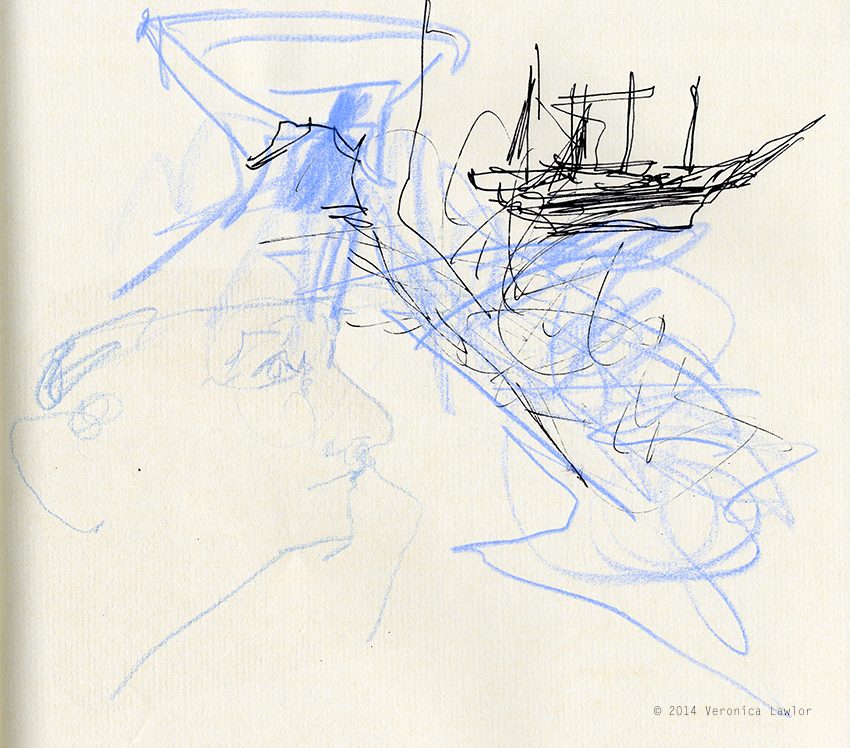 We got into a little speedster boat – “the bone-crusher” – and headed out of port. Bumping along with the surf spraying up around us, we chatted a bit and gazed out at the Morgan, our home for the next 24 hours. We were there for the experience, and in an age of digital mediation, for seventy nine people of various backgrounds to have the chance to experience a part of history first-hand – to feel the tactility of the rope, to smell the tar, to hear the creaks of the wood -was truly remarkable.
We got into a little speedster boat – “the bone-crusher” – and headed out of port. Bumping along with the surf spraying up around us, we chatted a bit and gazed out at the Morgan, our home for the next 24 hours. We were there for the experience, and in an age of digital mediation, for seventy nine people of various backgrounds to have the chance to experience a part of history first-hand – to feel the tactility of the rope, to smell the tar, to hear the creaks of the wood -was truly remarkable.
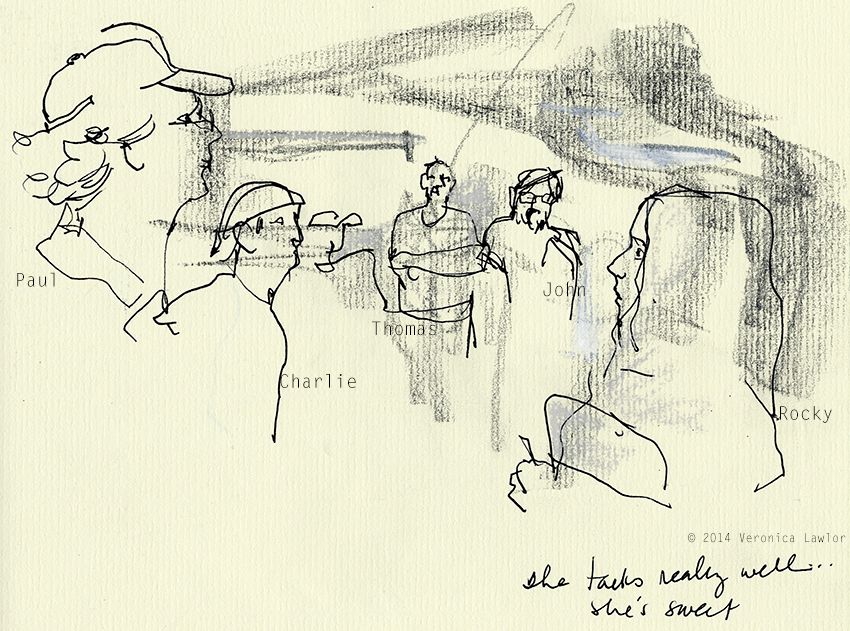 Once on board ship, Rocky, the third mate, brought us into the hold for our orientation. “The general principal,” she said, “is people on the inside, water on the outside.” Seemed reasonable to me. She told us to please talk with the crew, they were interested in our projects and reasons for being on board. BUT – she said – if they are running towards something on the ship, best to get out of their way! Then she took us to the forecastle, or fo’c’sle, where we would be sleeping, and told us to choose any empty bunk. I found one not too far from the door, a bottom, not top, bunk, and staked my claim. Then I went back on deck.
Once on board ship, Rocky, the third mate, brought us into the hold for our orientation. “The general principal,” she said, “is people on the inside, water on the outside.” Seemed reasonable to me. She told us to please talk with the crew, they were interested in our projects and reasons for being on board. BUT – she said – if they are running towards something on the ship, best to get out of their way! Then she took us to the forecastle, or fo’c’sle, where we would be sleeping, and told us to choose any empty bunk. I found one not too far from the door, a bottom, not top, bunk, and staked my claim. Then I went back on deck.
 I loved the atmosphere on board the ship at night. Provincetown glittered in the near distance, and the skies, despite the somewhat grim weather reports, were calm. There was a magical feeling about the silence of the ship, and I was not the only one enjoying it. Nearby, Robert had pulled a sextant out of the community chest below, and was aiming it at some fixed point on the horizon. He described the procedure of lunar navigation to me: “a giant protractor between the sun and the moon” he said. I was in awe of the mind that could conceive of the method.
I loved the atmosphere on board the ship at night. Provincetown glittered in the near distance, and the skies, despite the somewhat grim weather reports, were calm. There was a magical feeling about the silence of the ship, and I was not the only one enjoying it. Nearby, Robert had pulled a sextant out of the community chest below, and was aiming it at some fixed point on the horizon. He described the procedure of lunar navigation to me: “a giant protractor between the sun and the moon” he said. I was in awe of the mind that could conceive of the method.
Sean Bercaw, the second mate, sat down with me and I asked him what he thought of the old ways of navigation. “Sailors are a pragmatic bunch,” he said. “If they could have had GPS, they would have used it.” “Ah, well,” I answered, “but romanticism…” Sean finished for me:”It gets you dead!” he said emphatically. I had to laugh. All of my romantic notions aside, I was certainly happy the ship had GPS on board, especially since we’d be sailing close to shore in a storm the next day.
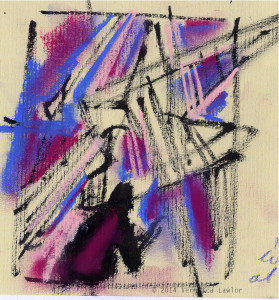 Sean moved off to take care of something (sailors work constantly) and I drew some of the massive amounts of rigging on board. So much line, so many ropes, the ship is like one huge cats cradle. It’s amazing to know how many lines there are and that each and every one has a purpose and connection to something on the ship. I read that sailors need to know each line by feel in the dark, and understand what it’s purpose is. That’s an almost uncountable number to me.
Sean moved off to take care of something (sailors work constantly) and I drew some of the massive amounts of rigging on board. So much line, so many ropes, the ship is like one huge cats cradle. It’s amazing to know how many lines there are and that each and every one has a purpose and connection to something on the ship. I read that sailors need to know each line by feel in the dark, and understand what it’s purpose is. That’s an almost uncountable number to me.
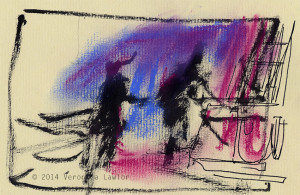 Â The crew of the Morgan were arriving on board from their day in Provincetown, and it was time to turn in. We were told to expect a 5 am wake up call in the morning, so we could get an early start in hopes of beating the storm. I headed down into the hold, passing Jason, who was standing on the deck in his bare feet. “I want to get a feel of what the Native Americans felt when they were on whaling ships.” he said. I thought again about the power of experience. We can never really know what someone else felt, especially in another time, but somehow by standing in the space where they stood we might hope to gain some empathy for our shared history, and for each other. With that thought in mind, I went below.
 The crew of the Morgan were arriving on board from their day in Provincetown, and it was time to turn in. We were told to expect a 5 am wake up call in the morning, so we could get an early start in hopes of beating the storm. I headed down into the hold, passing Jason, who was standing on the deck in his bare feet. “I want to get a feel of what the Native Americans felt when they were on whaling ships.” he said. I thought again about the power of experience. We can never really know what someone else felt, especially in another time, but somehow by standing in the space where they stood we might hope to gain some empathy for our shared history, and for each other. With that thought in mind, I went below.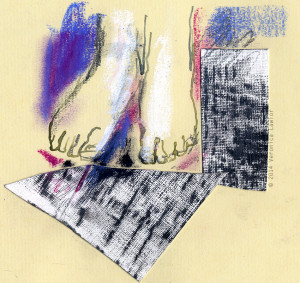
On my way to bed, I saw what seemed to me to be a typical view of a sailor in his bunk. I don’t know who these feet belong to, but I laughed out loud and loved the absolutely pragmatic (my new theme) solution to the problem of height on board the Morgan. I would use this image to remind myself to duck while walking around the hold during our journey.
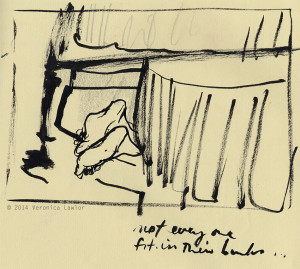 As I crawled into my little bunk and settled into position, I thought back to the first time I set foot on the Charles W. Morgan. All I could think about that day was the crew, what must they have felt as they pulled away from shore, destined to spend the next several years circling the ocean in a floating piece of bark. Did they feel regret watching the shore recede? Or excitement? And as the days and days of hard labor mixed with days of sheer boredom stretched into months and years, what did they think about? Dream about? Did they dream about rope? Knots? Whales? Home? Or were they just so exhausted that they didn’t dream at all? Looking up at the patterns in the wooden bottom of the bunk above me, four inches from my face, I wondered if they felt penned in by all the wood and the closeness of the rest of the crew. Personally I was surprised by how comfortable my little bunk was, with the curtain pulled across for privacy. It was tight, for sure, and I could only stretch out on the diagonal, but I liked the cozy, protected feeling it gave me. Not sure how I would feel in the midst of a storm out at sea, but fortunately I had the luxury of being docked next to a tourist town. Pragmatic thinking was beginning to seem more and more reasonable to me.
As I crawled into my little bunk and settled into position, I thought back to the first time I set foot on the Charles W. Morgan. All I could think about that day was the crew, what must they have felt as they pulled away from shore, destined to spend the next several years circling the ocean in a floating piece of bark. Did they feel regret watching the shore recede? Or excitement? And as the days and days of hard labor mixed with days of sheer boredom stretched into months and years, what did they think about? Dream about? Did they dream about rope? Knots? Whales? Home? Or were they just so exhausted that they didn’t dream at all? Looking up at the patterns in the wooden bottom of the bunk above me, four inches from my face, I wondered if they felt penned in by all the wood and the closeness of the rest of the crew. Personally I was surprised by how comfortable my little bunk was, with the curtain pulled across for privacy. It was tight, for sure, and I could only stretch out on the diagonal, but I liked the cozy, protected feeling it gave me. Not sure how I would feel in the midst of a storm out at sea, but fortunately I had the luxury of being docked next to a tourist town. Pragmatic thinking was beginning to seem more and more reasonable to me.
I lay in my little cocoon, the ship rocking me gently, thinking about these things, and listening to the sounds of the ship creaking mixed with the light snoring of my fellow voyagers and crew. Then, I fell asleep.
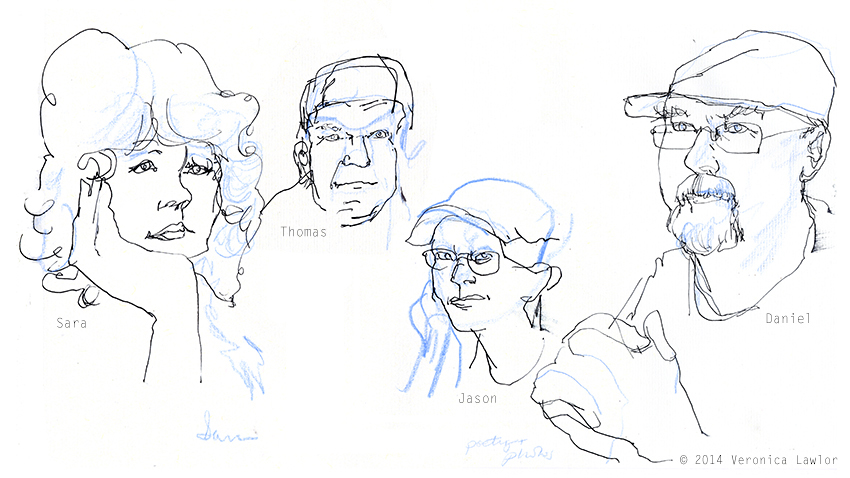
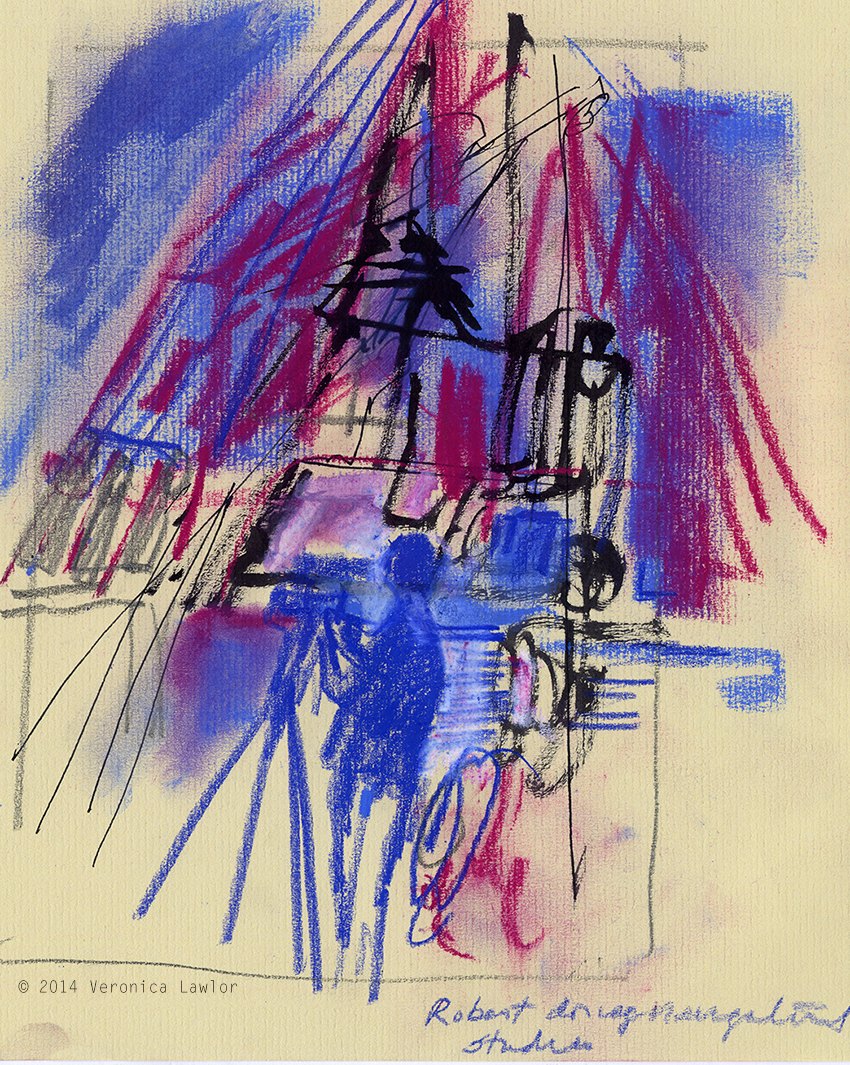
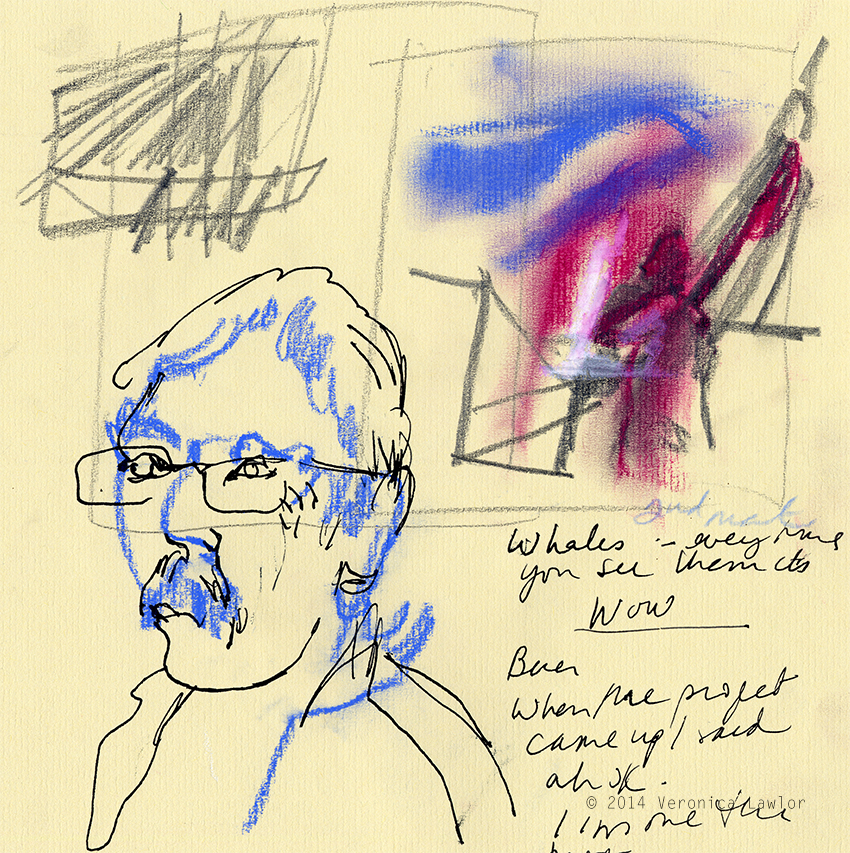
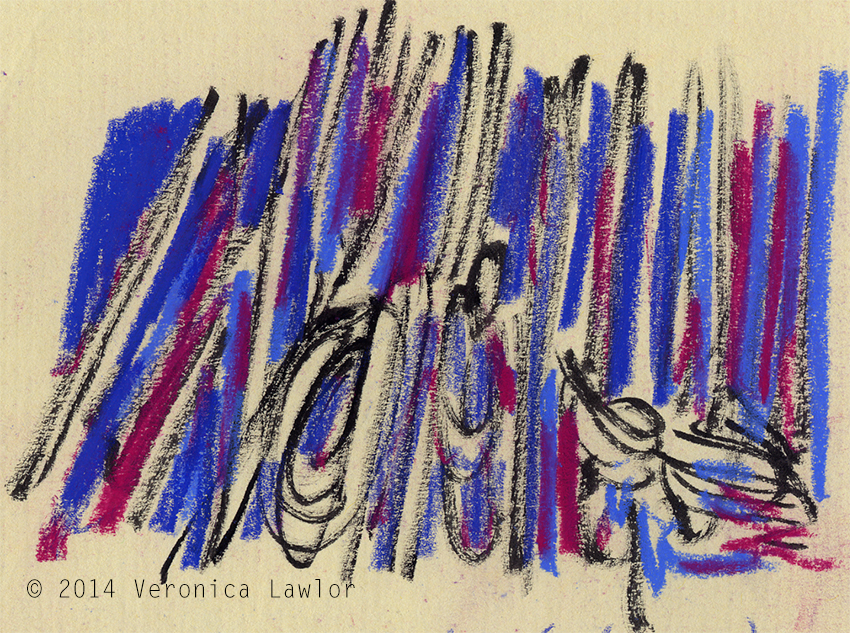
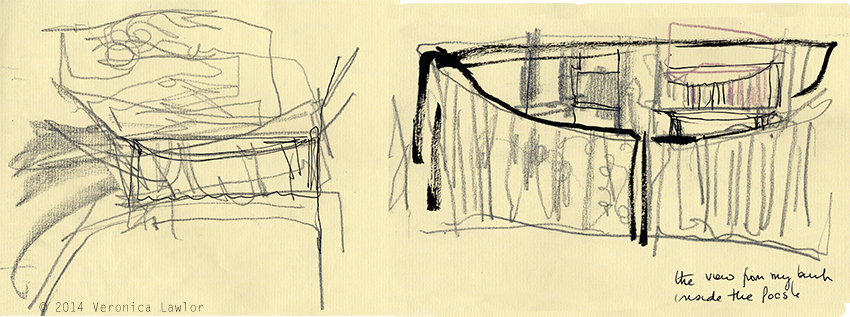
I can’t wait to read the next part and love your drawings. The pink & blue with the black works so well, how did you decide on that combination?
Hi Sue, thanks! The pink and blue with black just felt right when I was sitting on the deck that night. The ship feels so different in various situations and times, and I wanted to capture those changing moods with my reportage.